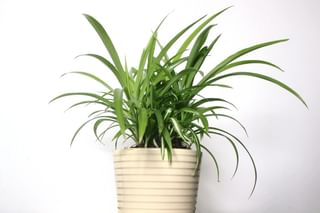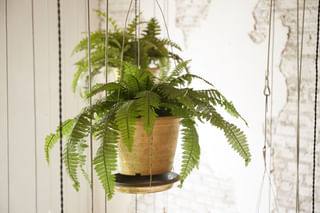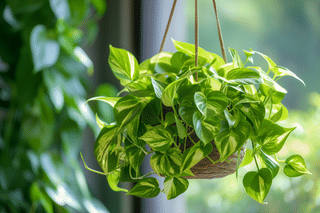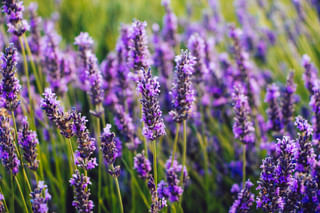The 10 Healthiest Houseplants for Your Home
Adding plants to your home is a great way to improve air quality, bring beauty into your space, and boost your well-being. In this plant care guide, we will explore the 10 healthiest houseplants for your home and see how and why they improve your health.

Did you know that adding plants to your home can improve air quality, bring beauty into your space, and boost your well-being? In this plant care guide, we will explore the 10 healthiest houseplants for your home and see how and why they can help you feel better.
Before we look at the 10 healthiest houseplants for your home, let's look at how you can find the perfect plant for you and your lifestyle! The healthiest plants should also help you with your mental health, not just your physical health.
These are the topics we're going to look at:
Let's see how houseplants can improve your health, both mentally and physically!
How can houseplants improve your health?
There are so many benefits to having plants in your home! Not only do they improve air quality, but they also add beauty and can boost your emotional well-being. Plants help to filter out harmful toxins from the air, so you can breathe more easily. They also produce oxygen, which gives you energy throughout the day. Aside from these physical benefits, plants also have a calming effect on your mind to help you reduce stress levels. So when you bring in new plants into your house, you're not just bringing nature inside, you're also improving your health and well-being. Win-win!
What is the best houseplant to improve my health?
Anyone can appreciate the beauty and benefits of houseplants. Not only do they add a touch of nature to your home, but they also help to purify the air and boost your mood. The key to finding a plant that's perfect for you is to consider your plant care style. For example, if you're someone who enjoys low-maintenance plants, succulents might be a good option. These hardy plants don't require much water or care, making them ideal for busy people or those with a more casual approach to plant care.
On the other hand, if you're someone who likes to take a more hands-on approach to plant care, a Boston Fern might be a better choice. These delicate plants require regular watering and humidity, so they're excellent for people who have the time and patience to give them the care they need.
The best houseplant for your health will be perfectly adjusted to your schedule, so they won't feel like a burden or a plant you have to go out of your way to take care of. No matter if you tend to forget about your plant or if you want to take care of it all the time, there is a plant out there for you!
Let's look at some of the healthiest houseplants you can bring into your home and what type of care they need.
Spider plants
Spider plants are grass-like houseplants that love moist soil. Not only are they easy to care for, but they also help to purify the air. Numerous studies have shown that spider plants can remove harmful toxins from the air. Besides improving air quality, spider plants also help to improve indoor air quality by releasing oxygen into the air. By doing this, a Spider plant can help to reduce the risk of respiratory problems, headaches, and fatigue. So if you're looking for a low-maintenance plant that can also improve your health, consider adding a few spider plants to your home.
Spider plant care summary
- Sunlight: Medium, indirect sunlight
- Watering: On average once per week
- Soil: Well-draining soil
- Fertilizer: Once every 2 weeks in the spring and summer
For more information about taking care of a Spider plant, have a look at "How to care for a spider plant".
Peace Lily

Peace lilies not only add a touch of green to your house, but they also grow white flowers! Peace Lillies help to clean the air, by removing carbon dioxide and VOCs from the air, making it easier to breathe. In addition, they release moisture into the air, helping to improve air quality and prevent dryness.
Peace Lily care summary
- Sunlight: Medium, indirect sunlight
- Watering: On average once per week
- Soil: Moisture-retaining soil, it loves moist soil
- Fertilizer: Once per month in the spring and summer
For more information about taking care of a Peace Lily, have a look at "How to care for a Peace Lily".
Rubber Tree

If you've got respiratory problems, you know that your house can be a source of discomfort from time to time. One of the most effective ways to improve air quality is to add a rubber tree to your home. Rubber trees are known to lower indoor ozone levels, which can make it easier to breathe and reduce your risk for respiratory issues. They also help to filter out harmful toxins from the air, making your home a healthier place to live.
Rubber Tree care summary
- Sunlight: Bright, indirect sunlight
- Watering: When the soil is dry, around once every 10 days
- Soil: Well-draining soil, it loves to be dry
- Fertilizer: Once every 2 weeks in the spring and summer
For more information about taking care of a Rubber Tree, have a look at "How to care for a Ficus Elastica (Rubber Tree)".
Alocasias
If you love large and unusual-looking plants, you might want to look into getting an Alocasia plant! There are many different Alocasias, but they all have the same care requirements! Besides being true statement plants, Alocasia plants are known to lower indoor ozone levels, which can make it easier to breathe and reduce your risk for respiratory issues. They also help to filter out harmful toxins from the air, making your home a healthier place to live.
If you're a beginning plant owner, you might want to try some of the other plants in this post first, because it's not the easiest plant. Luckily, it tells you when it's not happy and the signs are quite easy to read.
Alocasia care summary
- Sunlight: Bright, indirect sunlight
- Watering: On average, once per week
- Soil: Well-draining soil, it stores a lot of moisture in its stems
- Fertilizer: Once every 2 weeks in the spring and summer
For more information about taking care of an Alocasia, have a look at "How to care for an Alocasia Zebrina".
Snake Plants

Snake plants are the true champions when it comes to hard-to-kill plants. These plants thrive on neglect and are completely fine with not being watered for weeks at a time. Snake plants can stay small if you don't have a lot of space, or grow large if you give them a lot of space to grow. They can survive in direct sunlight, low-light environments, and everything in between. Snake plants can grow anywhere, which makes them perfect plants to spread out throughout your home where they'll clean the air for you. They help to make breathing easier while bringing their large patterned sword-like leaves anywhere you put them. If you want a plant that you can forget about, that you can put in any space in your house, the snake plant is the next plant for you!
Snake plant care summary
- Sunlight: Any light level
- Watering: On average, once every 14 days
- Soil: Well-draining soil, it loves droughts
- Fertilizer: Once every month in the spring and summer
For more information about taking care of a Snake plant, have a look at "How to care for Sansevierias".
Boston Ferns
Have you been looking for a plant that improves your health but doesn't have any broad leaves? A plant that brings a new texture to your house? The Boston Fern is a great candidate and is one of the few plants that would love to permanently grow in your bathroom.
Boston Ferns don't just look great, they also improve air quality and help to filter out harmful toxins from the air, making your home a healthier place to live. Boston Ferns thrive in humid environments, like your bathroom, and prefer medium to bright indirect sunlight.
Boston Fern care summary
- Sunlight: Medium to bright indirect sunlight
- Watering: On average, once per week
- Soil: Moisture-retaining soil, it likes moist soil
- Fertilizer: Once every 14 days in the spring and summer
For more information about taking care of a Boston Fern, have a look at "How to take care of a Fern indoors".
Golden Pothos
So far we've looked at plants that stay compact, but perhaps you're looking for a plant that grows long vines and turns your house into an indoor jungle. The Golden Pothos might be THE plant for you!
The Golden Pothos is a popular houseplant that improves air quality and helps to filter out harmful toxins from the air. It's also one of the easiest plants to care for, making it perfect for beginner plant owners. The Golden Pothos can grow in many light conditions, from bright indirect sunlight to low-light environments, and prefers to be on the drier side. This makes it a great plant to spread out throughout your house and improve the air quality in many rooms.
The Golden Pothos is also a plant that grows very quickly, which is perfect for those that don't have the patience for a plant to grow larger over a year or more.
Golden pothos care summary
- Sunlight: Medium to bright indirect sunlight
- Watering: On average, once per week
- Soil: Well-draining soil
- Fertilizer: Once every 14 days in the spring and summer
For more information about taking care of a Golden pothos, have a look at "How to care for a Golden Pothos".
English Ivy
The English Ivy is a popular plant that usually grows outdoors, but can also be brought indoors. It's a plant that loves to grow in moist soil, so it'll need to be watered occasionally preferably once every 3-5 days. It loves moist soil, but it doesn't like to sit in a puddle of water, so a drainage hole in its pot is very important.
The English Ivy has been known to help improve air quality by filtering out harmful toxins from the air. It's also been known to help people with allergies and asthma because it removes the allergens from the air. So if you're looking for a healthy houseplant that helps improve your indoor air quality, the English Ivy is perfect for you!
English Ivy care summary
- Sunlight: Low light to bright indirect sunlight
- Watering: On average, once every 3-5 days
- Soil: Well-draining soil
- Fertilizer: Once every 14 days in the spring and summer
For more information about taking care of an English Ivy, have a look at "How to take care of an English Ivy".
Succulents and Cacti

If you're someone who always forgets to water their plants, or you're looking for a plant to put on that bright windowsill, you might be looking for a succulent of a cactus. Both succulents and cacti clean the air in your house and remove up to 87% of VOC from the air. They're also very hands-off plants that love to sit in direct sunlight. Succulents and cacti are great and calming plants because they require very little work and they love it when you forget to water them for several weeks. The biggest mistake people make with these plants is they water them more than once per week. As long as you keep them in a sunny spot and you don't water them more than once per week, these plants will stay happy and healthy in your care.
Succulents and cacti care summary
- Sunlight: Direct sunlight
- Watering: On average, once every 14 days
- Soil: Well-draining soil, they love droughts
- Fertilizer: Once per month in the spring and summer
For more information about taking care of a succulent, have a look at "How to care for a succulent (indoors)".
Herbs
And last but not least, there is no better plant for your mental and physical health than herbs. Herbs have been used for centuries to improve mental and physical health. They are packed with antioxidants, vitamins, minerals, and other nutrients that help keep your body healthy. They also have healing properties that can help cure several illnesses and conditions. Plus, they add flavor and aroma to your food, making every meal more enjoyable. And last but not least, herbs often have a delicious smell that fills your house with the smells of summer.
There are very many different types of herbs that require different types of care, so it's hard to give you care directions for them. The best way to pick herbs to grow is to think about which herbs you use often and which you enjoy smelling or eating.
Personally, I love lavender. So maybe that's a great one for you to start with as well. It's very easy to care for, smells amazing, and has many healing properties.
For more information about taking care of Lavender, have a look at "How to take care of Lavender".
Conclusion
In this post, we've looked at 10 of the best plants to improve both your physical and mental health. Any of these plants are great to bring into your home, as they'll all do their part in making your home a healthier and more comfortable space to live in. If you're looking for a healthy addition to your home, consider one of these top 10 healthiest houseplants.
Share this guide with your friends and family to help them create a calming and healthier home!
Thank you for reading this post! I hope it helps you to keep your plants healthy and beautiful! If you're looking for more guides on specific plants, you can always request a plant guide to get a guide for the plant you have trouble with.
Test your plant care knowledge
Quiz completed!
Want to learn more? Sign up for my newsletter to receive free tips in your inbox!
Sign up now!























